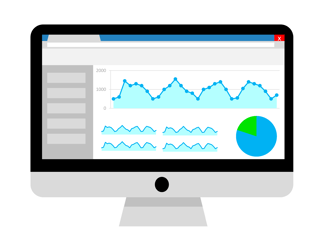Digital Analytics: the great ally of User Experience (UX)

Digital analytics has become increasingly important as an integrated discipline in our design processes. Data analytics and user research have joined paths to offer a holistic view of the insights we get from users. This gives us a more exhaustive understanding of the customer journey, all in a single research experience.
User Experience professionals bring various techniques into play, such as user tests, ethnographic studies, interviews, focus groups, and so on. But this type of research—albeit praiseworthy for helping us figure out users’ needs, frustrations and expectations as they relate to the use of digital products and services—is no longer enough. We need to support our research with quantitative data in order to make a more assertive design decision.
Incorporating a ‘data culture’ into the design processes
Until recently, analytics was only linked to specific departments or to Marketing exclusively, but it’s gradually becoming a transversal discipline and is already part of our UX strategy or CRO (Conversion Rate Optimization).
To do this, we apply data-driven or data-based design methodologies in any project, be it software development or sites for eCommerce or lead capture.
Incorporating a data culture into our work creates countless advantages:
- Optimizing applications or websites, thereby improving the user/customer experience.
- Identifying business opportunities to build new functionalities or characteristics for a product or service.
- Validating our solutions. Every idea we design arises from business and user research. But still, ideas are hypotheses to confirm or refute. And analytics will help us in this process.
In addition, data becomes more important in projects that require CRO strategies—finding conversion problems requires constant measurement of our digital assets. The qualitative and quantitative data will help us form hypotheses that are geared toward making decisions and improvements, as you will see explained soon.
What is data-driven design?
Designing based on data requires adapting design methods and techniques, guiding them to achieve business objectives. Before starting to design the solutions, we must answer the questions:
- What are the business and application objectives?
- Who is our audience?
- What strategies and actions will we take to achieve our goals?
- How are we going to measure it?
Work methodology
Without going into detail, a good methodological basis includes these activities:
- Understand, research, define and conceptualize the value proposition and then help establish business objectives and KPIs.
- Design interface solutions, doing so while following agile methodologies.
- Measure, learn and optimize. All ideas that we design after our investigations are hypotheses that we will have to confirm or refute.
CRO-specific strategies
 CRO stands for Conversion Rate Optimization.
CRO stands for Conversion Rate Optimization.
We can find many definitions for what it means to do CRO in a digital business model, but to me, this best describes it:
When we talk about CRO, we are talking about a discipline and methodology aimed at improving the commercial and business efficiency of any digital asset (web, application, landing, etc.) through the 1). identification of improvement points 2). generation of hypotheses that explain the inefficiencies detected 3). design of actions to correct them and 4). implementation and monitoring of the effectiveness of those actions
Furthermore, all of this assumes one clear objective: to improve the profitability of whatever digital business we work with.
The development of the comprehensive UX strategy for these conversion-focused projects goes, once again, through the analytical management of data, segmenting and identifying those elements and/or pages with the greatest contribution to the conversion.
What kind of companies do CRO?
Any company that 1. has a website, application, SaaS models, eCommerce, etc., and 2. That wants users to end up carrying out a beneficial action for the digital business portion of the organization (purchase, registration, contact, etc.).
Is there a work methodology to do CRO?
Of course. First, we need to understand that making optimization strategies involves following a methodology that encompasses a fair amount of effort.
This work proposal goes through a several phases:
- Phase 1: Know the business. When tackling a CRO project, we must have a broad and complete vision of the digital scene and the business model on which we’ll be working.
- Phase 2: Analytical audit. Analyze the company’s aptitude for digital analytics. This helps find a starting point to propose the measurement tools we’ll use.
- Phase 3: Analysis. Study the audience: will/will not convert; customers/users. We study the quantitative data and analyze the qualitative data. We look for possible problems, inefficiencies or other ideas for improvement.
- Phase 4: Hypothesis. After analyzing, we formulate hypotheses.
- Phase 5: Objectives, actions and KPIs. We define objectives and propose corrective or persuasive actions for each objective. It will depend on each proposed objective.
- Phase 6: Experimentation plan. We will plan A/B and multivariate tests to validate the hypotheses that we consider necessary.
It’s a continuous cycle that we can integrate into an agile methodology.
Measuring tools
 Monitoring the results of our strategy is essential for the success of our projects. Knowing the results helps us analyze and make decisions that correct the course of the strategy followed.
Monitoring the results of our strategy is essential for the success of our projects. Knowing the results helps us analyze and make decisions that correct the course of the strategy followed.
In our UX discipline (as in any other), we have a great toolbox to use depending on the project and strategy to follow. Our traditional UX work tools are joined by others specific to data analytics, such as Google Analytics, Adobe Analytics or more specific ones like VWO, Optimizely, Mixpanel, to name a few. With them, we must be able to convert data into useful information that helps us understand the user, find out what our customers like the most, discover potential market segments, identify patterns of behavior, identify vanishing points in our conversion funnels, and so on.
What I named are some tools that I currently like quite a bit, but as we know, in the world of technology, what is relevant today is no longer relevant tomorrow 😉.
Heat and behavior maps
On-page analysis
Hotjar/Clicktale/CrazyEgg are tools specifically designed for a class of tasks pertaining to checking where users get stuck, where they decide to abandon and the time it takes for users to complete forms.
Surveys
Typeform (both NPS [Net Promoter Score] and general)
Test A/B
Optimizely allows you to create different versions of a website quickly without the need to program them in order to analyze them and decide which is the most suitable core for further development.
Google Optimize allows the creation of different variants in different types of tests, as well as HTML and CSS customization of the site to be tested.
Others
Mixpanel is a simple but different approach to the world of web analytics. It has interesting online marketing functions to improve site visitor engagement.
KISSmetrics is a cloud platform for web analytics whose main characteristic is displaying intelligence associated with each person or client, monitoring in real time the actions users take while navigating the site and collecting information on reference, search, behavior and conversion funnel sites.
Dashboard
One of the most important parts of the data analysis process is showing results. Data Visualization is the discipline responsible for identifying the best ways to graphically represent data, using instruments that turn the data into insight that’s accessible at any time. Dashboards are responsible for showing all our KPIs at a glance.
- Google Data Studio is Google’s free data visualization tool. Since it’s launch, it has had many modifications and integrations. With it you can analyze data and create useful visuals with a relatively low learning curve.
- PowerBI, from Microsoft. I had been using Tableau and Google Data Studio for a while, but recently I started to use this tool and the truth is that it’s very powerful. You can create a Pro-licensed corporate account or create a free account for yourself. In both cases, Power BI is ready for your desktop. Check out our resource guide for learning PowerBI, here!
Conclusion
User experience analytics helps us identify new user needs and respond with new services to meet them. It also helps us detect, correct and optimize our applications, functionalities or websites continuously, which impacts conversions and improves profitability in the ambit of digital business, because we can figure out where to invest our efforts.
-1.webp?width=352&name=airport%20(1)-1.webp)

